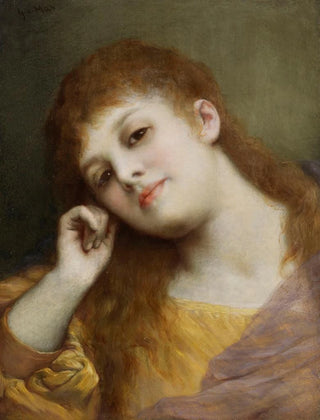Painting Portrait of a Young Girl - Gabriel von Max | Art print


View from behind

Frame (optional)
Introduction captivante
The "Portrait of a Young Girl" by Gabriel von Max is a masterpiece that transports viewers into a world filled with delicacy and mystery. Created at the end of the 19th century, this painting embodies an artistic vision where youth is celebrated through a lens of unique sensitivity. The young girl, whose gaze appears both dreamy and penetrating, invites deep contemplation. This portrait, beyond its simple representation, evokes a story, a frozen moment in time, where beauty and innocence meet. The charm of this work lies in its ability to touch the soul, evoke emotions, and inspire reflections on the nature of the passage of time.
Style and uniqueness of the work
Gabriel von Max's style is distinguished by its realistic approach, blended with a touch of idealism. In this portrait, the finesse of the details is remarkable. The delicate features of the young girl, the brightness of her complexion, and the subtle expression of her face demonstrate great technical skill. The interplay of light and shadow, skillfully orchestrated, gives the work an almost tangible depth. The color palette, soft and harmonious, enhances the atmosphere of intimacy emanating from the painting. Every element, from the choice of clothing to the pose of the young girl, seems carefully thought out to create a balanced and emotive composition. This singularity, combined with impressive mastery of painting, makes this work an essential part of the 19th-century artistic repertoire.
The artist and his influence
Gabriel von Max, painter and art professor, is often recognized for his exploration of themes related to psychology and human emotion. His work is not limited to simple figurative representation; he seeks to capture the very essence of his subjects. Influenced by the Symbolist movement, Max was able to incorporate elements of mystery and spirituality into his creations. His fascination with human psychology is reflected in the "Art print of a Young Girl," where emotions are palpable and each gaze tells a story. His innovative approach paved the way for many contemporary artists, who sought to explore similar themes, blending beauty with psychological depth.

Matte finish

View from behind

Frame (optional)
Introduction captivante
The "Portrait of a Young Girl" by Gabriel von Max is a masterpiece that transports viewers into a world filled with delicacy and mystery. Created at the end of the 19th century, this painting embodies an artistic vision where youth is celebrated through a lens of unique sensitivity. The young girl, whose gaze appears both dreamy and penetrating, invites deep contemplation. This portrait, beyond its simple representation, evokes a story, a frozen moment in time, where beauty and innocence meet. The charm of this work lies in its ability to touch the soul, evoke emotions, and inspire reflections on the nature of the passage of time.
Style and uniqueness of the work
Gabriel von Max's style is distinguished by its realistic approach, blended with a touch of idealism. In this portrait, the finesse of the details is remarkable. The delicate features of the young girl, the brightness of her complexion, and the subtle expression of her face demonstrate great technical skill. The interplay of light and shadow, skillfully orchestrated, gives the work an almost tangible depth. The color palette, soft and harmonious, enhances the atmosphere of intimacy emanating from the painting. Every element, from the choice of clothing to the pose of the young girl, seems carefully thought out to create a balanced and emotive composition. This singularity, combined with impressive mastery of painting, makes this work an essential part of the 19th-century artistic repertoire.
The artist and his influence
Gabriel von Max, painter and art professor, is often recognized for his exploration of themes related to psychology and human emotion. His work is not limited to simple figurative representation; he seeks to capture the very essence of his subjects. Influenced by the Symbolist movement, Max was able to incorporate elements of mystery and spirituality into his creations. His fascination with human psychology is reflected in the "Art print of a Young Girl," where emotions are palpable and each gaze tells a story. His innovative approach paved the way for many contemporary artists, who sought to explore similar themes, blending beauty with psychological depth.
12,34 €






